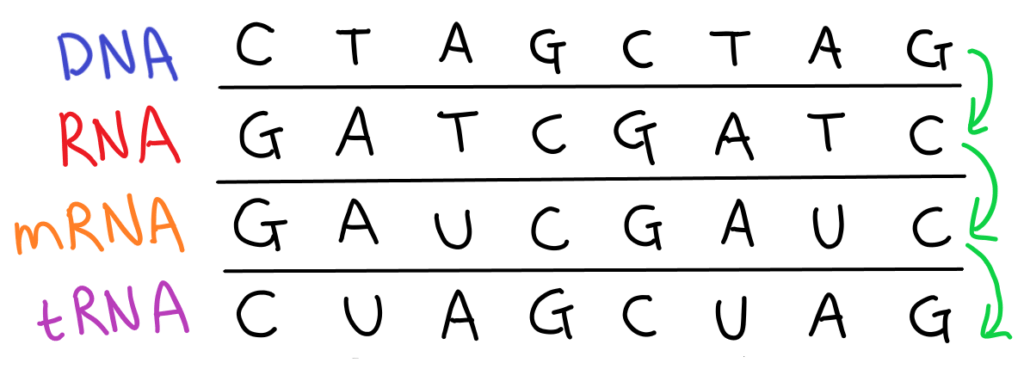B.8 - Nucleic Acids
What are Nucleic Acids?
Nucleic acids are genetic materials that express themselves by the synthesis of proteins by cells. There are a lot of different nucleic acids in the body but we’ll leave most of them to the biologists. We’ll just deal with:
- DNA
- RNA
- mRNA
- tRNA
Nucleotides
Nucleotides are the basic building blocks of all nucleic acids, the simplest units of genetic material. They consist of:
- Phosphate group
- A pentose sugar
- A nitrogenous base
These nucleotides can combine to form polynucleotides in condensation reactions.

The Nitrogenous Bases
There are 5 nitrogenous bases that occur in nucleic acids; A (adenine), guanine (G), cytosine (C), thymine (T) and uracil (U). These are given in the data booklet!

RNA vs DNA
RNA
- Single strand
- Ribose sugar
- CUAG nitrogenous bases
- Generally shorter
- Contains less genetic material
DNA
- Double strand held together by H-bonds
- Deoxyribose sugar
- CTAG nitrogenous bases
- Generally very long
- Contains like, everything.
DNA
In DNA, two strands are held together by hydrogen bonds between the nitrogenous bases. Only certain bases align correctly to form hydrogen bonds.

The hydrophilic (water loving) phosphate and sugar backbone is found on the outside of the DNA, with the hydrophobic (water hating) nitrogenous bases wrapped tightly inside. This makes the outside of the DNA soluble in water because it’s exterior is hydrophilic (water loving) due to the polar OH groups on the sugar and ionic negative charges on the phosphate. This makes DNA very stable as it’s hydrophilic exterior ‘protects’ the hydrophobic bases from water.
And now for the less interesting stuff about what DNA does.
DNA packaging
When DNA is not in use, it coils itself tightly around basic (not starbucks) proteins called histones and forms a chromosome to protect itself from damage. This coiling also allows it to fit into the nucleus in an orderly fashion.
When a portion of the genetic code is needed, that portion ‘unwinds’ and exposes what is needed before coiling up again.
DNA Replication
DNA replicates during mitosis (and probably other things) when a parent cell divides to produce 2 daughter cells.
- Enzymes ‘unzip’ sections of the DNA
- Free nucleotides bond to the newly formed single strand of DNA
- The new nucleotides undergo condensation reactions with deoxyribose and phosphate groups to form the DNA backbone
Because DNA strands are complimentary (they are an ‘opposite match’ to each other), DNA can easily replicate, as only one free nucleotide will bind correctly to the nitrogenous base in the DNA single strand.
DNA Transcription
DNA transcription is similar to DNA replication, except for 3 key differences; only a small portion of the DNA is needed, the copy made is mRNA and not DNA and that the base T is replaced by U in the mRNA.
What is mRNA and why is T replaced with U?
mRNA is ‘messenger’ RNA, which leaves the nucleus and contains information on building proteins. T us replaced by U so that the RNA can leave the nucleus, as the base T cannot leave the nucleus.
This mRNA is then found by a ribosome, which decodes the mRNA and builds the protein in a process called DNA translation.
DNA Translation
In DNA translation, mRNA is decoded by ribosomes to form a protein. The sequence of the 4 nitrogenous bases code for the 21 naturally occuring amino acids.
Each amino acid has one or more 3 letter/base codes called codons that tell the ribosome that it’s needed in the protein. There is no need to memorise any of these codons but you should at least know that they exist 😂

During DNA translation, tRNA (transfer RNA) carries the amino acid and has the complimentary (opposite) code to mRNA.
The difference between DNA, RNA, mRNA and tRNA
Basically:
- DNA is double strand CTAG
- RNA is single strand CTAG
- mRNA is single strand CUAG
- tRNA is complimentary to mRNA
For example:

Genetic modification
Genetic modification is when the genetic material of an organism is altered in order to give the organism certain traits, for example:
- Giving crops better drought resistance, a higher yield of products etc
- Genetically modifying cells e.g. yeast to make certain products like insulin.
This is usually done by inserting the ‘useful’ DNA from other organisms into the DNA of the target crop or cell.
Genetically Modified Foods
As climate change is affecting conditions across the world, the need to use less water and less chemicals on crops are making Genetically modified crops more common. They do however have their disadvantages.
Pros:
- Better drought resistance
- Less water consumption
- Better taste
- Higher yield
Cons:
- Effects of altered DNA on the human body not fully understood
- Modification causes DNA diversity in the species to reduce
- If the GM plant is vulnerable to for example a certain disease, it could wipe out the whole species.